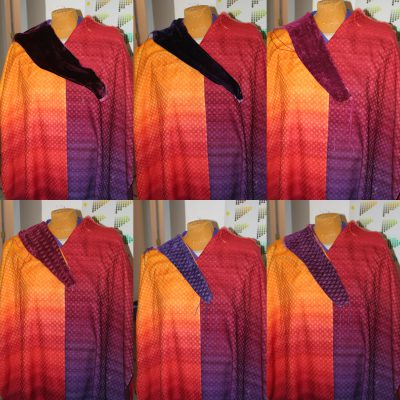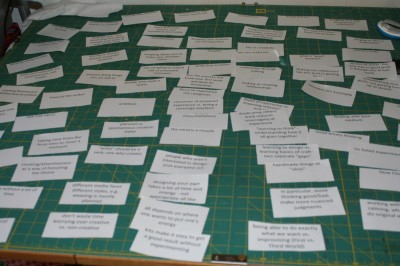Been quiet the last few days, mainly because I been BUSY!
Rather than bore you with a blow-by-blow recount, here is a photo that sums up much of what I’ve been doing:

Here are six mockups for the collar. Left to right, starting with the top row, they are:
- variegated wine-and-purple rayon velvet, hand-dyed
- deep purple rayon velvet, also hand dyed
- handwoven fabric, rayon chenille weft, 1/4 satin. Dyed wine-red after weaving.
- handwoven fabric, sparsely spaced maple leaves, chenille dominant side up. Painted with burgundy dyes after weaving.
- handwoven fabric, closely spaced maple leaves, blue-purple.
- handwoven fabric, closely spaced maple leaves, burgundy.
While I still need to sit back and think more closely about things, here are my initial thoughts:
- Not fond of either velvet. Came out too dark, and feels unrelated to the rest of the piece.
- Also not fond of the “solid” chenille mockup at top right; it’s not as gorgeous as the velvet and just looks boring.
- The sparse maple leaves at bottom left feel jarring to me – changing the spacing upsets the unity of the piece without really gaining anything to me
- My favorite so far is the piece at bottom right, but I think there is considerably more sampling yet to do.
Next on the slate for collar fabric is to dye some rayon chenille weft and do some serious sampling. I think I can play some very interesting tricks with cross dyeing to get the leaves one color and the chenille another, but I’ll have to dye the chenille first. I will also need to change the aspect ratio on the leaves – the chenille yarn is thicker than the 60/2 silk weft I had been using, which stretched the leaves badly out of shape lengthwise. By adjusting my weave, I should be able to get the leaves to look right again. But it will take more fiddling.
I’m also in the midst of dyeing all the fabrics for the muslin – the colors are coming out muddy and ugly on the flannel, though, which is unfortunate. Since I bought the flannel from Joann Fabrics, I’m guessing it was treated with some kind of stain resistant or flame retardant finish which is interfering with the dyes. (I did scour before using, but apparently not enough to remove whatever was on it.) It will still be OK for getting the rough color sequence, but I think I may hand-paint another set of panels next weekend, this time getting flannel meant specifically for dyeing.
And, as if that weren’t enough, I’ve started a new project. I have been toying with the idea of compiling my essays on craft into a book for awhile now, but yesterday I decided to stop toying and just do it. However, since the essays are quite different in style, tone, etc. I’ve realized that I can’t just toss them into a compilation and be done with it; instead, I’m planning on rewriting them into a single piece. The exact format is still TBD – I’m considering combining them with narrative for a series of craft parables – but I’ve already started collecting the themes/ideas from each piece and looking to see what natural groupings arise. I spent this morning using some visual organization techniques I learned in project management school to help sort through the themes:

And that is all I have to say about it, for now. (Watch this space!)
Back to the dyepots! I have now dyed all ten panels for the next muslin, and need to paint the last two knitted blanks for the final two panels. I also need to dye some rayon chenille yarn, so I can sample some more collar possibilities. I think there are some really exciting possibilities with cross-dyeing.

I like 3 and 4. I think that color sets off the body of the coat the best. The leaves are so small they look a little “busy,” I’m afraid, and don’t contribute anything to the overall look of the garment.
My thought is that none works because it adds another element to an already ‘busy’ neckline. The color clash, if you will, of the left and right sides needs to be brought together by the collar. In remembering the band you wove for your wedding coat, would it be possible to do something of the same utilizing a color progression that would echo what you’ve got now? –Sue in MA